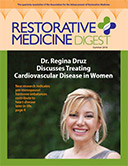Even though research into the role and effects of biophotons that the body produces endogenously remains a fringe area of science, the health benefits of externally administered light have been recognized for a while. Photobiomodulation therapy (PBMT), using the low-dose application of red or near-infrared light, is a noninvasive, therapeutic approach with the potential to stimulate, enhance, and repair cell and tissue architecture and restore function. PBMT holds great promise when used as a transcranial application, for a broad array of neurophysiological and neuropsychiatric conditions, such as traumatic brain injury, stroke, neurodegenerative disorders (for example, Alzheimer’s disease, Parkinson’s disease), depression, and post-traumatic stress disorder.
How Does PBMT Work?
The molecular and cellular mechanisms of action for PBMT are not entirely understood. It is known that photons are absorbed by cytochrome oxidase, the terminal enzyme in the mitochondrial electron transport/respiratory chain. The greater the activity of cytochrome oxidase, the greater the mitochondrial consumption of oxygen and metabolic energy production as a result of increased rates of oxidative phosphorylation. Neurons rely on mitochondrial oxygen metabolism far more than other cells, which likely explains
the neuroprotective effects and functional improvements reportedly observed with PBMT.1-6
Photons absorbed by cytochrome oxidase may also be able to disassemble nitric oxide (NO). NO is thought to inhibit mitochondrial enzyme activity, especially in damaged or hypoxic cells. When NO is disassembled, mitochondria can consume oxygen, metabolize more glucose, and produce ATP more efficiently.7,8
When mitochondria absorb photons during PBMT, there is a transient increase in the production of reactive oxygen species (ROS). It is thought that this brief surge in ROS may stimulate signaling pathways that promote antioxidant and apoptotic effects that result in microbial death. This is particularly relevant when underlying infections may be contributing to the pathogenesis of neurological disorders.9
Mounting evidence suggests that immune function and metabolic function are inextricably connected. The activation of oxidative phosphorylation plays a key role in differentiating macrophages from the proinflammatory phenotype (M1) to the anti-inflammatory phenotype (M2). M2 macrophages, and similarly activated microglia in the brain, are instrumental for the phagocytosis and removal of toxic protein aggregates, such as beta amyloid plaque and alpha synuclein, which are associated with neurodegeneration.10,11,12
This shift in expression of functional phenotypes may be crucial to the mechanism of action and beneficial neurological effects noted with PBMT use. Microglia have also been found to regulate blood flow in the small vessels of cerebral vasculature.13
The impact that PBMT has on mitochondrial activity and ATP production, as well as on cerebral blood flow, go a long way to explain the beneficial neurological effects reported during its use. However, scientists believe the long-lasting effects, which in animal models are evident after brief exposure to PBMT, can only occur if PBMT activates signaling mediators and transcription factors that alter protein expression. Multiple signaling pathways and transcription factors that are activated following PBMT have already been identified, including interactions with ion channels and upregulation of neuroprotective heat shock proteins and growth factors.14
Clinical Implications
Neuroinflammation and hypoperfusion are key features of neurodegenerative disorders, traumatic brain injury, and certain neuropsychiatric conditions. As part of your restorative medicine whole-person protocol for patients with these conditions, the application of PBMT over time may potentially improve both of these factors.
References
- https://onlinelibrary.wiley.com/doi/full/10.1002/lsm.22471#lsm22471-bib-0011
- https://pubmed.ncbi.nlm.nih.gov/30145725/
- https://www.ncbi.nlm.nih.gov/pmc/articles/PMC5523874/
- https://onlinelibrary.wiley.com/doi/full/10.1002/lsm.23232
- https://www.nature.com/articles/srep30540
- https://link.springer.com/article/10.1007/s12035-017-0852-4
- https://www.mdpi.com/2218-1989/12/2/103/htm
- https://pubmed.ncbi.nlm.nih.gov/31848399/
- https://www.sciencedirect.com/science/article/abs/pii/S0098299715300200
- https://www.ncbi.nlm.nih.gov/pmc/articles/PMC7303283/
- https://www.ncbi.nlm.nih.gov/pmc/articles/PMC7947196/
- https://jneuroinflammation.biomedcentral.com/articles/10.1186/s12974-021-02312-x
- https://www.nature.com/articles/s41467-021-25590-8
- https://ieeexplore.ieee.org/abstract/document/7488285
